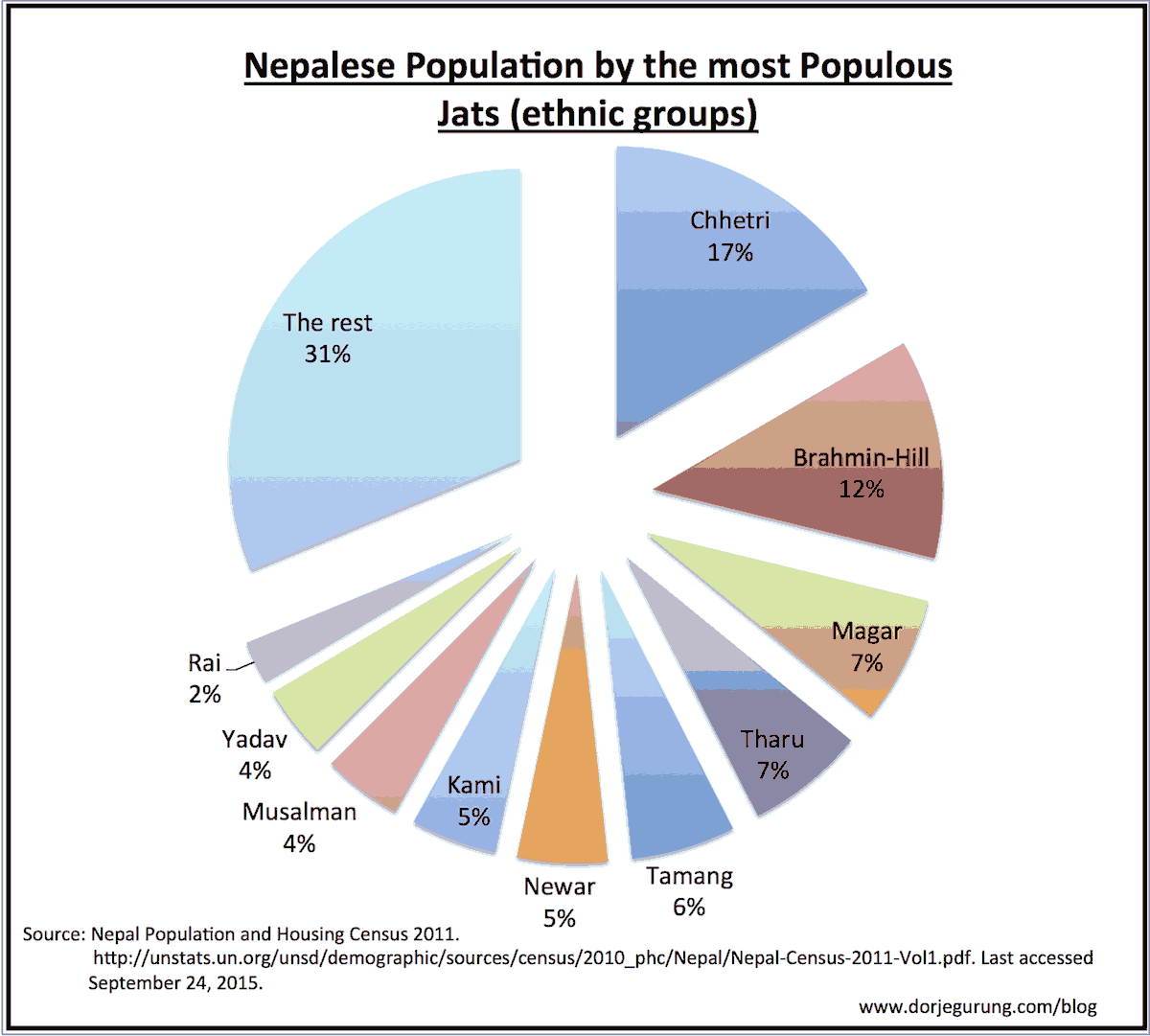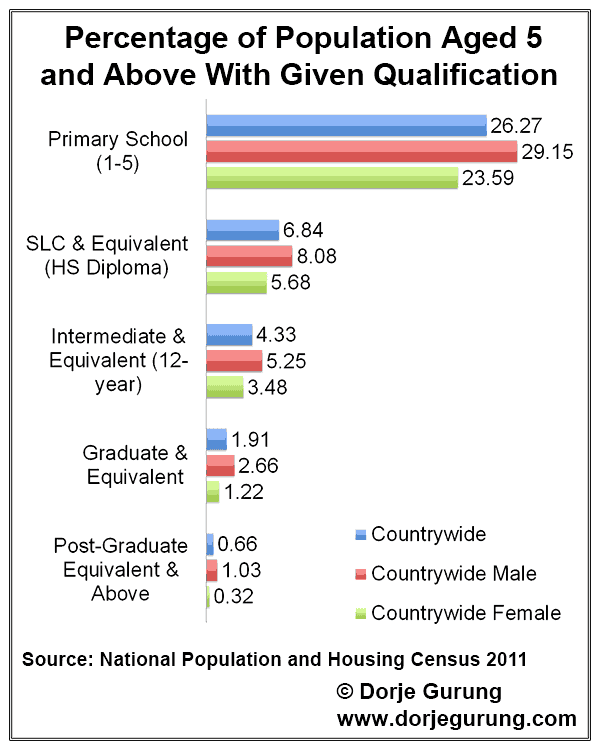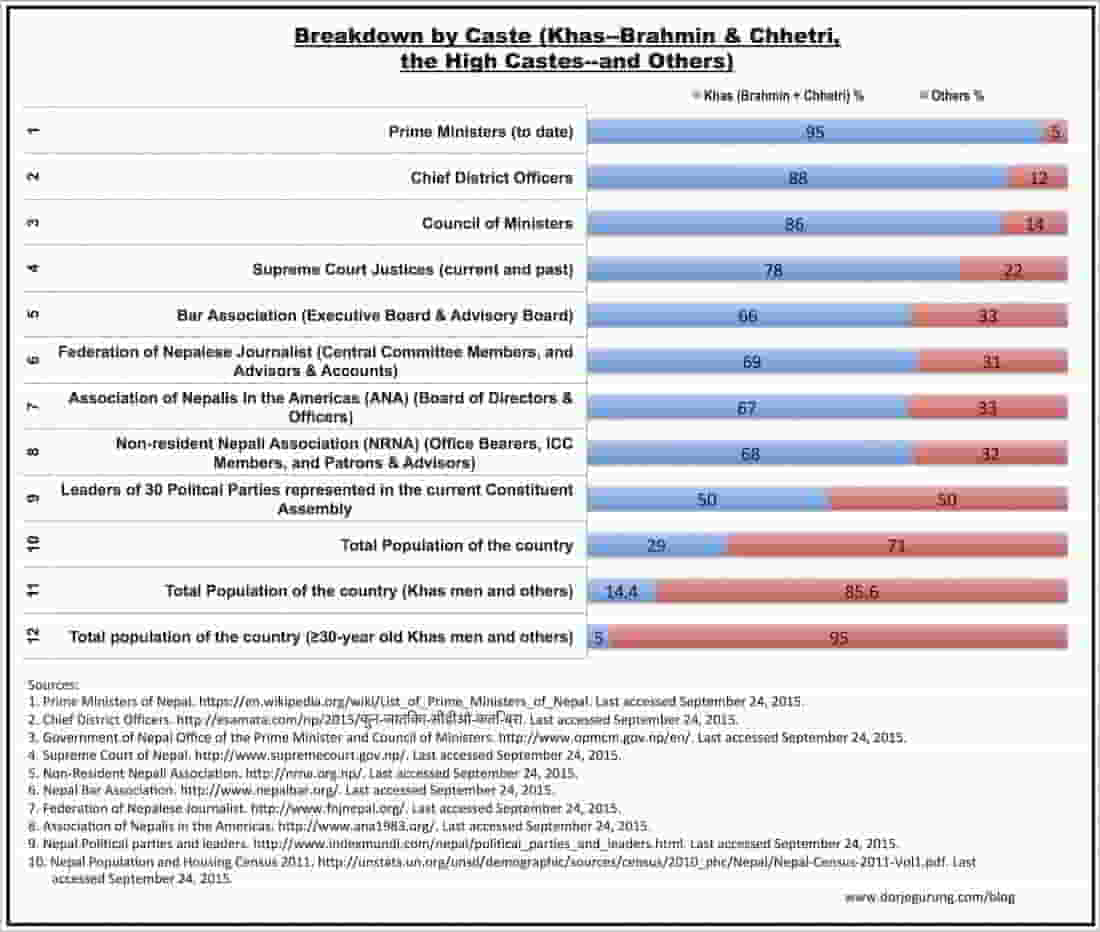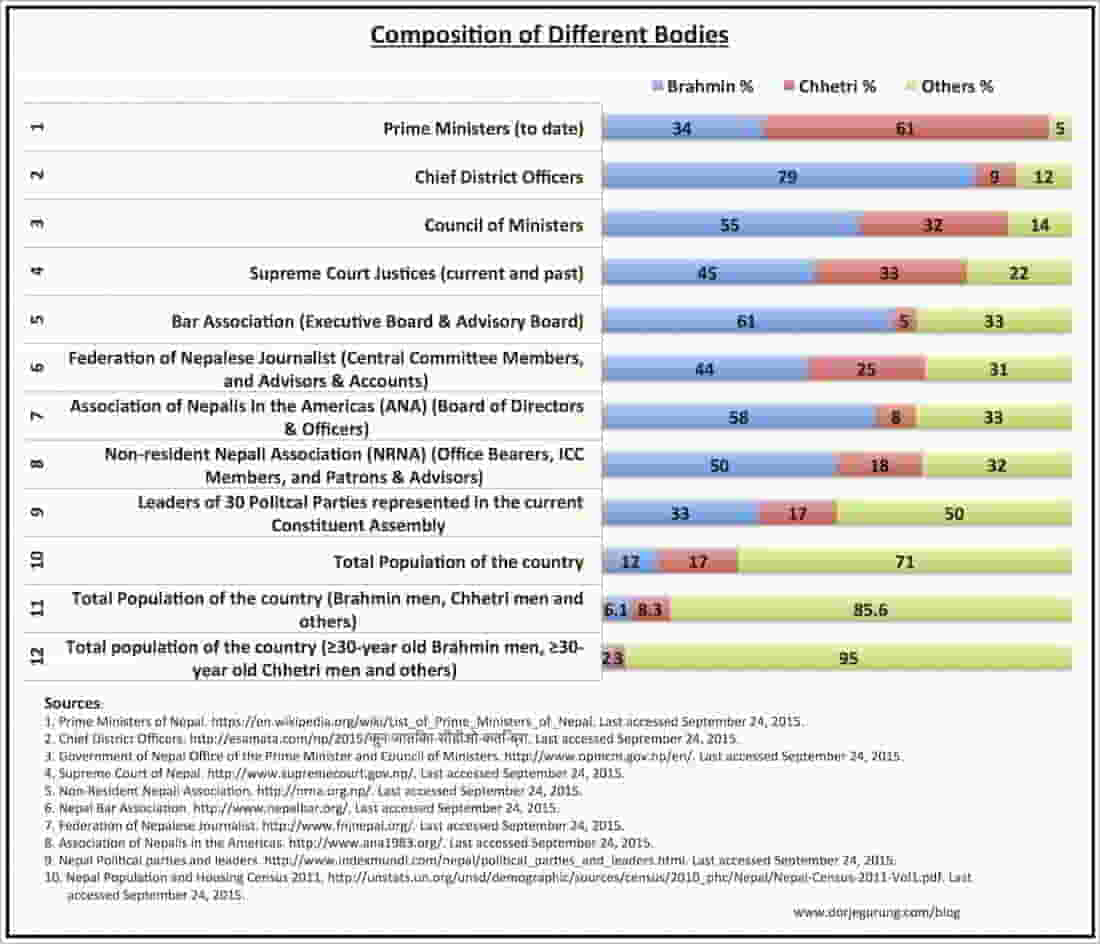It’s been 100 days since the Madhesi’s protests in the Southern Plains. One of their grievances is lack of representation in the government and positions of power and authority, which has seen them — just as many other ethnic groups in the country — being exploited throughout the entire modern history of the country. According to the 2011 Census Report, Terai (where the Madhesis live) account for half the population of the country. The Madhesis‘ representation in the power structure of the country however is minimal!
Or take the Dalits who, depending on the sources, represent anywhere from 12 to 25% of the population, have next to no representation!
Forget representation in the power structure, when the Kathmandu elite, who are part of that structure, treat Nepalese living on the margins and far out from the periphery of the power center with arrogance, self-righteousness and extreme condescension, you know there is a problem with the system.
The incredibly homogeneous power structure of Nepal is an anachronistic slap in the face of the equally incredibly diverse population of the country.
I have made and shared some charts showing just that on social media (such as Facebook) and in the first blog post in the series about the statistics that follow. Here, I reproduce two of those charts, share additional charts, provide details of how and where I specifically got the data, how I arrived at the numbers and some commentaries.
Here’s the first one, based on the 2011 Census Report.

Hill so-called high caste men, Brahmin (Bahun) and Chhetri men, referred to together as Khas, are disproportionately represented in positions of power and authority. (The rest of the people of the country, incidentally, slot into the other (lower) castes. You can learn more about the caste system here, here and here.)
As you can see from the chart above, the percentage of Khas in the country is less than thirty, less than a third of the population.
[bctt tweet=”Khas people are disproportionately highly represented in positions of power and authority.” username=”Dorje_sDooing”]
But, here’s the second chart. (Click here or on the image for the original.)
And here’s another one. (Click here or on the image for the original.)
For more on the breakdown of each body, follow the links below. (The percentage of Khas is equal to the sum of Brahmins (Bahuns) and Chhetris which appear at the bottom of each table.)
This article was the source for entry number two, breakdown of Chief District Officers.
Incidentally, if you notice any mistakes in the tables, I would appreciate your pointing that out in the comment section below.
The following data was used to arrive at the demographic numbers. The tables and pages listed below are of those in the 2011 Census Report.
| SN | Item | Population | Comment/Source of Data in the Census Report |
| 1. | Total | 26,494,504 | Page 1. |
| 2. | Males | 12,849,041 | Table 15, p. 50. |
| 3. | Khas males | 3,815,209 | Arrived at by assuming equal split between males and females. |
| 4. | Males aged 30 or over | 4,758,565 | Arrived at by using age and population data for males found in table 15, pp. 50-52. |
Entry twelve was calculated by assuming the percentage of Khas men of thirty or over to be the same as the percentage of that age group in the general population. The other assumption was that every office holder was thirty or older.
So, those that mostly control and rule the country, the Khas males of 30 or over, belong to a group that make up 5% of the population!
And yet, there are those in Nepal who wonder why the Madhesis in the South are protesting. Or why the women or the Dalits or the Limbus or Tamangs have been asserting their ethnic identities more and more since 1990 and have also been protesting themselves.
[bctt tweet=”The rulers, Khas males of 30 or over, belong to a group that make up 5% of the population.” username=”Dorje_sDooing”]
There are those who don’t understand why ALL Nepalese don’t buy into their “patriotism” for the country based on their argument of/for “unity in diversity”!
What’s more, when I posted these charts on social media, some people not only explained away the data saying higher castes had higher education levels but also accused me of trying to create “animosity” between castes etc.
That, however, is not without precedent it seems.
In ‘Caste, Ethnicity and Inequality in Nepal‘, describing how it was before 1990, during the Panchayat System of governance, David Gellner writes:
‘With no reservations as in India, nor even any development initiatives specifically targeting “backward” groups, the lion’s share of the fruits of development and rapidly expanding educational opportunities and rewards went to those groups who were already well connected and had long established traditions of literacy and academic study, namely, bahuns, some chetris, and some (principally high-caste) newars (BCNs). On the rare occasions when figures were collected on the proportion of BCNs in high education or the professions, they were considered too explosive to publish.’
So much so that Gopal Gurung was jailed in 1988 for his book “Hidden Facts in Nepalese Politics.”
I have yet to find more recent data on caste and education level. But Harka Gurung in “Trident and Thunderbolt: Cultural Dynamics in Nepalese Politics” provides a very thorough historical context for our current social and political system, including data on literacy and income (for 1996) and representation in the government (for 1854 and 1999) by caste and, just as you might guess, they are pretty bad.
Here is the most recent education level data for Nepalese in general.

As you can see the data is not very reassuring and there’s lots one can say about them. But just two observations for now.
Firstly, suffice it to say that if only education got the hill so-called high castes into positions of power, then a vast VAST majority of lower castes are highly HIGHLY uneducated, which is a major cause for concern!
Secondly, even if everything were equal, or as my economics teacher Manuel at UWCAD used to say, “Assuming ceteris paribus,” which they are NOT, it’s statistically impossible for such a small group of Khas men to come out so disproportionately highly educated AND so in control of the power structure.
But of course, the explanation for this gross structural inequality is NOT only education. A big part of the explanation — if not THE explanation — lies in structural privilege, something alluded to by David Gellner and which is supported partly by our very peculiar social system: the Caste System.
Legalized when the first legal code was formulated in the country in 1854…by the hill so-called high castes and partly endorsed by Hinduism but mostly by customs and traditions, the Caste System has cultivated a culture, attitude and mentality that supports this warped power structure. Dor Bahadur Bista’s book “Fatalism and Development: Nepal’s Struggle for Modernization” gives an excellent account of that.
[bctt tweet=”Caste-system-cultivated culture, attitude & mentality supports a warped power structure.” username=”Dorje_sDooing”]
Suffice it to say that in as diverse a population as Nepal, such homogeneity in the power structure, so stark in its lack of female representation and that of other ethnic groups, has been — and still is — damaging to Nepalese communities and the country as a whole. Along with lack of education and corruption, the Caste System is responsible for the social, political and economic stagnation of the country. Twenty years ago, it became the catalyst for a ten-year civil war in the country! But even that didn’t bring about adequate change!
But, research has shown that the more diverse a group, any group or organization — social group, professional group, political group etc. …you name it — the more productive, the more efficient, the more creative, the more progressive the group.
It’s also the more challenging to everyone concerned, contributing greatly to personal, social, political as well as other development and growth, depending on the kind of group it happens to be!
I can personally attest to that because I am myself a product of education and professional career in very diverse cultural settings and with very diverse social, cultural and national groups.
But the details of all that will remain the subject of another post.
What do you think?
10:03 pm Nov. 24 Update
Where it used to say “According to the 2011 Census Report, the Madhesis account for half the population of the country” in the first paragraph, Madhessis has been replaced with “Terai (where the Madhesis live)” to be consistent with the wording in the census report.
12:28 pm, June 28, 2016 update
This is a correction to the percentage of Prime Ministers. Turns out, Gehendra Bahadur Rajbhandari, who I have down as a Prime Minister during the reign of King Mahendra, was never one!
@Dorje_sDooing After KN. Bista resigned, Rajbhandari’s designation is found as For.M 1/n. @mukesh2006 @digitalsubway pic.twitter.com/upOk22FqTV
— Diwaker Jha (@dkZha) June 28, 2016
So, the percentage of non-Khas Prime Ministers is even less than 5%!
References
National Population and Housing Census 2011.
Gellner, David. Caste, Ethnicity and Inequality in Nepal. Published in 2007, the byline reads: “Nepal faces the danger of an all-out ethnic war breaking out in the Tarai between madhesis and parbatiyas. But, in most of the country there are so many complex and cross cutting ethnic allegiances which make a Sri Lankan-type polarisation unlikely. In the eastern Tarai, however, with its 30 per cent population of parbatiyas, there is a very real possibility that “two majorities with minority complexes” could confront each other in bloody vendettas.”
Gurung, Gopal. Hidden Facts in Nepalese Politics. First published in 1985. The title says it all.
Gurung, Harka. Trident and Thunderbolt: Cultural Dynamics in Nepalese Politics. Quoting from the introduction: “The formation of Nepal as a state evolved through the appendage of peripheral regions of the mountains and plains to the core of the hill realm. Hinduism constituted the state ideology while the khasa-kura (Nepali) language was made the official vehicle of communication. Hinduisation was accompanied by colonisation of tribal areas and social ordering of tribes into hierarchical castes. Therefore, national identity and later Nepalese nationalism was rooted in the image of hill Hindu elites and their Nepali (khasa-kura) mother-tongue.”
Bista, Dor Bahadur. Fatalism and Development: Nepal’s Struggle for Modernization.
Additional References
These were added after the publication of the post because of their relevance. They are updated continuously.
The Record (Oct. 2017). How Quotas Provided a Footing but Left Inequality Unresolved: Dalits in the Local Election.
The Record (Dec. 2017). In local government, Khas Arya men dominate all major posts.
The Record (Dec. 4, 2017). Adibasi Janajatis’ local election representation close to share of population, but with variations within.
The Record (Jan. 20, 2018). Khas Arya biggest winners in five provinces, Janajati and Madhesi in one each.
The Record (March 03, 2018). Dalits and women the most under-represented in Parliament.
The Kathmandu Post (Oct. 16, 2018). Brahmins and Chhetris land most government jobs. “Brahmins and Chhetris, two dominant classes in Nepali society, continue to lead in terms of landing civil service jobs despite an inclusive hiring policy reserving quotas for Janajatis, Dalits and other disadvantaged groups.” [Added on Oct. 19, 2018.]
Research Gate (Nov. 2015). The Ain of 1854 and after: Legal pluralism, models of society and ethnicity in Nepal. [Added on Nov. 26, 2018.]
The Kathmandu Post (Feb. 5, 2019). Structural blindness. “The foundation of modern Nepal lies in the caste system of governance.” “Lower castes faced greater punishments than higher castes for the same crime. for example, in 1940, for protesting against the Ranas, Tanka Prasad Acharya, a Brahmin, was imprisoned; his four friends, charged with same crime, were hanged and shot to death.” [Added Feb. 5, 2019.]



Hello Dorje, thank you so much for this blog post and the charts in particular! They will really help me to highlight the legacy of political exlusion of minority groups from decision-making bodies in Nepal for my presentation.
– Sonam
Dear Sonam,
You are welcome. There’s lot more of course. If you are interested, you should also have a look at the lack of representation in the fourth pillar of democracy: the media! This blog https://www.dorjegurung.com/blog/2021/10/fnj-is-of-for-and-by-khas-arya-men/ is about the composition of the office bearers of the Federation of Nepalese Journalists.
Thank you pointing that out! Indeed, the lack of respresentation of minorities in various important socio-political spheres of Nepal is appaling and tragic. But people like yourself give me the hope and motivation to change that! Thank you once again!
Without a doubt a commendable job! Will be interesting to see how it, everything mentioned above, looks after, say, 1990. Would appreciate if you or anyone visiting here/reading this can put efforts together to accumulate the said data. Nevertheless this is what the picture of Nepal thus far which should change (which is changing I am sure, the only concern/worry remains how much of time it is taking to), look different 20 years down.
Binod, thanks for your kind words.
Indeed, a comparison of the composition pre- and post-1990 — of all the ministers, all the CDO’s etc. — would be an interesting study.
Its very intersting dissegration and information for me as a learner to work for community. Thank you sir.
You are welcome Sanjeev!